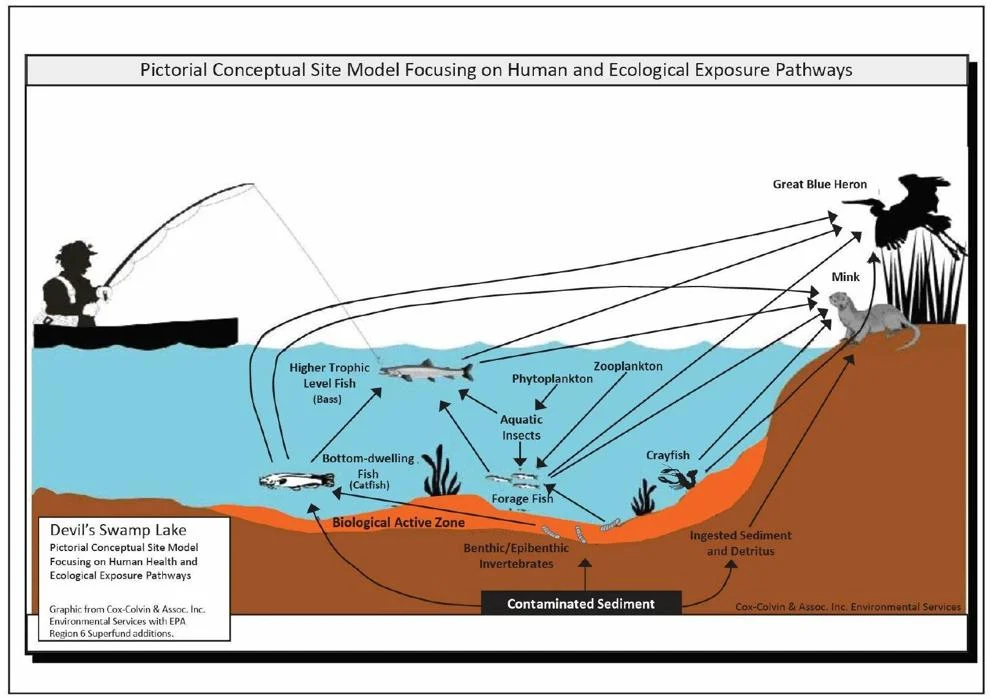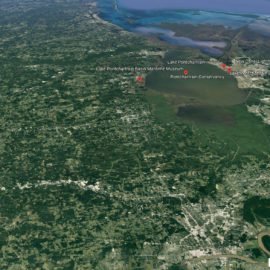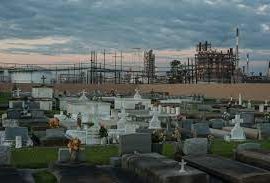
The Devils Swamp Superfund site is still polluted and when will it be cleaned up?
As far back as the 1960s, concerns were being raised over pollution at Devil’s Swamp, where families once crawfished and hunted north of Baton Rouge. “When will we ever be able to lift the advisory against eating fish and other critters out of the swamp?” said Jerry Speirs, a New Orleans attorney whose family owned farmland adjacent to the swamp when the contamination was first reported. His late father-in-law, Dave Ewell, sought to draw attention to the issue in 1969. But more than a half-century later, the area that is now a Superfund site has still not been cleaned up. New plans running on two separate tracks promise a 30-year cleanup, accompanied by possible projects to improve natural resources and provide infrastructure for future fishers and hunters. But none of the plans call for compensating affected families in a nearby majority-Black community. Federal and state officials have begun a new review of the effects of toxic hazardous wastes that have contaminated Devil’s Swamp to determine whether additional steps are required to mitigate damage to natural resources, including several threatened and endangered species, or to compensate the public for their loss.
nola.com
Pollutants, including PCB’s, have been reported and have made the swamp un-fishable.
Contaminated with a variety of toxic chemicals, including cancer-causing PCBs, since the 1960s, Devil’s Swamp is a 12-square-mile cypress-tupelo freshwater swamp along the east bank of the Mississippi River just north of downtown Baton Rouge and adjacent to the Alsen community. The new assessment is being overseen by the Louisiana Departments of Environmental Quality and Wildlife & Fisheries and the U.S. Fish & Wildlife Service, in their roles as public trustees for the area’s natural resources. It will be conducted in parallel with a long-delayed effort to contain and reduce hazardous wastes at the 37-acre Devil’s Swamp Lake Superfund Site, which sits within the assessment area and whose contamination is believed to have come from the same industrial sources. The Superfund cleanup, which is overseen by the federal Environmental Protection Agency, is not scheduled to begin until early 2024. Environmental activists and local residents expressed support for the new effort, while also criticizing why it has taken so long. “It’s just mind blowing to me that here we are so many years later and they haven’t really worked on cleaning the site up in a meaningful way,” said the Sierra Club’s Darryl Malek-Wiley. “The adjacent environmental justice community members have historically depended on the flora and fauna and wildlife and plants of Devil’s Swamp as a source of food,” said Wilma Subra, a scientist who has worked with the Louisiana Environmental Action Network and provided technical advice to Alsen residents about the swamp contamination under a grant funded by EPA. “Sometimes, that’s all the food they had.”

(Google Earth)
Some of those near the water want the state to buy out their homes.
During an October 2019 hearing by the EPA on the proposed Superfund cleanup, Baton Rouge Metropolitan Council Member Chauna Banks and state Sen. Regina Barrow joined several Alsen residents in asking why the $4 million proposed for it couldn’t be better used to buy out nearby residents. In an interview Friday, Banks said she still believes buying out Alsen residents would be a better solution. But she also said it was hypocritical for DEQ to launch the new study at the same time it ignores complaints from community residents about pollution from other facilities in the area.

(Photo by Keith Horn, Louisiana Department of Environmental Quality)
The damage has spread to other water bodies.
The new study beginning the natural resource damage assessment used data collected from the swamp since the early 1980s to determine there was enough evidence to show a link to a nearby Clean Harbors facility, said Gregory Langley, a spokesman for DEQ, which is leading the assessment. Based on fish tissue sampling, the state began posting signs warning against fishing, consuming fish, or contact recreation, including swimming in the lake and surrounding area in 1986. But the swamp has historically been a popular local food resource for nearby residents who fished for catfish and crawfish from its waters. And hunting stands are still found in trees. The swamp also is home to a variety of other species, including belted kingfishers, raccoons, minks and great blue herons, as well as formerly threatened bald eagles. It may also be visited by threatened manatees, which could make their way north up the Mississippi from the Gulf of Mexico, and endangered pallid sturgeon, one assessment says. The southern segment of the swamp being targeted by the new effort was found to be largely contaminated by PCBs and other chemicals released by Rollins Environmental Services, which operated a neighboring waste treatment, storage and disposal facility from the early 1970s until 1997. To the north, part of the swamp is home to two Superfund cleanups dubbed Petro Processors, where contamination problems date back as early as the 1950s, and involve a variety of other companies.

(Environmental Protection Agency)
The sites history and ownership are murky, like the water.
The history of ownership and operation of the Rollins property since then is complicated. Rollins acquired Laidlaw Environmental Services in 1997, and took on the Laidlaw name. Laidlaw then acquired Safety-Kleen Corp. in 1998, and renamed itself Safety-Kleen. In 2002, Safety-Kleen sold the property to Baton Rouge Disposal LLC, which still owns it. Clean Harbors Baton Rouge LLC, however, operates the facility and is responsible for both the new natural resource damage assessment and the lake Superfund cleanup. As such, Clean Harbors is responsible for the costs of the new study and any projects it recommends, as well as for the Superfund site cleanup. In a Sept. 1 letter to DEQ, Eric Jarrell, an attorney representing the company, said it agreed to participate in the new natural resource assessment, while preserving its rights to disagree with the findings. Company officials did not respond to requests for comment.

(EPA)
PCB’s were a common chemical that was banned in 1979 after studies showing it caused damage to nature.
PCBs, or polychlorinated biphenyl compounds, the main contaminant of concern in the swamp, were industrial chemicals historically found in oils used to insulate electric transformers until they were banned in 1979 because of their threat to human health and wildlife. A variety of other toxic chemicals, including hexachlorobenzene, hexachlorobutadiene and heavy metals, have been found in samples of sediment and water dating back to 1977. The U-shaped lake within the swamp was excavated in 1973 and 1974 to provide material to reinforce a levee along the nearby Baton Rouge Barge Canal, also known as the Baton Rouge Barge Harbor. The deeper lake area in the swamp ended up capturing greater quantities of the hazardous chemicals, resulting in its first being proposed as a Superfund site by EPA in 2004. But EPA didn’t add the site to the national list of Superfund projects until 2020, and according to the site’s official EPA website, approval of the proposed plan to clean up its wastes won’t occur until early 2024. EPA declined to comment on the delay, but the state DEQ says the company, EPA and the U.S. Department of Justice are in negotiations over the contents of a consent decree that will be the legal framework for the cleanup.
The cleanup will be a two year process followed by a 30 year monitoring plan.
The Superfund project plan approved by EPA in 2020 calls for capping sediment containing PCBs in a drainage ditch running from the Clean Harbors property through the swamp and into the northern end of the lake. The cap would include a 6-inch-deep base layer of sediment with up to 6 inches of armoring on top, aimed at blocking migration of chemicals and combating against storm erosion. The armoring material is not identified. The project would take up to 2 years to design and build, and would also include 30 years of monitoring. At the end of the 30 years, the assumption is that the contaminants found in the Superfund site area would be below levels raising human health concerns. In 2019, the project was estimated to cost $3.8 million. Another complication facing that project might be confirmed during the natural resource study.
A damaged levee has been deemed responsible for letting the polluted water seep into other waterways.
Portions of the levee along the barge canal failed when the Mississippi River rose particularly high in 2020, and concerns had already been raised by the Army Corps of Engineers that changes in the way water flows between the contaminated parts of the swamp and the barge canal had added PCBs to the sediments on its bottom. “The levee in question has been in decline since 2011, and was found to have completely failed in 2020,” Langley said. The levee, largely on private property, is no longer considered a Corps project, as it was originally built in anticipation of the barge canal enticing major industry to the area, which never happened. In a 2016 memo to EPA officials overseeing the Superfund site, Corps officials’ sampling of shoal material in the canal in advance of scheduled maintenance dredging turned up levels of PCB ranging from 6 parts per billion near the river to 22 parts per billion in the area closest to the adjacent lake. The Corps pointed out that it would be responsible for additional cost of properly disposing such sediment if it didn’t meet federal contamination requirements, which could significantly increase the cost of keeping the barge channel dredged in the future. Until then, the dredged sediment was released into the Mississippi River. “While these concentrations are 20-fold less than those believed to pose an ecological risk, we are concerned that repeated uncontrolled releases from Devil’s Swamp Lake may result in accumulation of contaminants over time to levels that would require special handling of dredged material from the channel’s upper reach during infrequent maintenance,” the memo said.
Clean Harbors Environmental company is already working in the area.
Clean Harbors also is operating its treatment and storage facility adjacent to the swamp under rules spelled out in several consent agreements with EPA and the DEQ. The site includes four closed hazardous waste landfills. Those agreements are aimed at reducing additional releases from the Clean Harbors facility into the swamp, and govern monitoring of the movement of polluted water in underground aquifers off the site. The site has several wells that are pumping millions of gallons of contaminated wastewater a year from several on-site locations, which must be treated before the cleaned water is released into the Mississippi River.
These Superfund sites and the lack of funding to clean them up has been a constant problem especially when we keep finding them.



